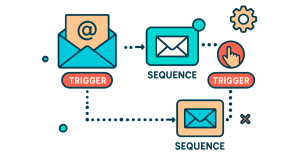Timing is everything in our world, especially since it is leaning more and more towards personalized experiences. If you run any sort of email campaign, it’s a good idea to take steps to align it with your lead or contact scoring workflow. A proper lead scoring model can get you far in marketing to prospects and customers. It helps you target those who are actually interested at the right time in their sales journey and lets you know which leads should be left to nurture further. Continue reading to learn more about the relationship between emails and lead scores!
What is Lead or Contact Scoring?
Before we can apply email to this, we need to have a clear understanding of what lead or contact scoring actually is. The terms are interchangeable. Some technology stacks, like the emfluence Marketing Platform use the phrase contact scoring and others use lead scoring. Lead scoring is how you keep track of who is interacting with your company and how often. This is a ranking system that scores each action or non-action based on a predetermined value. You’re ranking based on many attributes from demographic to behavior. This is crucial to set up because it can inform your marketing and sales teams on their next steps. It will cue them in on when to reach out to leads and how to adjust campaigns.
There are many advantages to a lead scoring system. You should notice an increase in revenue and conversions, and you’ll find that you’re working more efficiently and saving your team on time and money. This makes a lot of sense because when you’re able to target right customers at the right time, you’re not spending as much time chasing down the wrong people.
How to Lead Score
Every company is going to lead score a bit differently. While this isn’t an easy process, it is certainly one that is worth the investment. You’ll need to examine your company’s past customer data and pinpoint the important attributes that will lead to calculating a score.
You’re in control here and can alter the point system as you see fit. Is downloading a whitepaper a major indicator of interest to you? Then you could assign five points. Is clicking on career page an indicator that this might not be a potential lead? You can subtract points.
Weigh both sides. You’ll want to look into the behaviors and characteristics of customers that did convert and those that didn’t. You can then create a lead scoring model based on what you’ve observed.
It’s not just the data that will help you along. You can also tap into your other resources and your network. For example, ask your sales reps what their experience is. They usually know exactly what’s going on with leads since they’re the ones that directly communicate with them.
If you’re looking for even more insight, turn to the customers themselves! You can reach out after a purchase to see if they’re willing to participate in an interview that will help you determine what prompted their buying decision. If you’re able, it’s best to get in touch with those who had both a short and long sales cycle, so you get good insight on their thought process.
Lead Nurturing Workflows
You can easily align your lead scoring model with your email strategy. Much of this can be automated using additional tools to make the process easier to manage for you. The purpose of creating a lead scoring model is to know how and when to nurture a potential customer so tying it into your email campaigns works well.
Targeted emails can be sent depending on certain actions your customer takes or based on a certain score they’ve reached. By fine-tuning your email strategy to account for lead scores, you’ll be able to guide potential customers along the sales funnel. Examples of what you can score in relation to email include:
- Downloading a guide from your email.
- Clicking on an email link.
- Abandoning a cart before checkout.
- Email or website engagement.
- Viewing your website or an email multiple times.
- Demographics.
Once you have your lead scoring model determined, the fun can begin. There are endless options and opportunities to design your emails around lead scores. One example is to offer various levels of discounts depending on where your lead is at in the sales funnel. Someone who has just signed up for emails may get a few reminders of your trial offer. If they’ve clicked on links in your email, you may try to entice them again with an additional discount. The next time around, they fill out basic information and make it to the checkout page without making a purchase. While all this is happening, the score on this lead continues to add up so you’re aware of exactly what your customer is doing. Once it reaches a certain score, you may decide to offer up a major discount, getting them to convert.
CRM Marketing Workflow Example
If you’re unsure where to start with your targeted content, we’ll help you out! A great go-to way to jumpstart this process is by creating a lead scoring campaign where your emails are created to grade your leads on how often or how little they’re interacting with you. It’s ideal to include multiple opportunities for engagement here and have them all properly scored ahead of time.
Start new leads off with a welcome email. If they open it, that’s already a good sign and you can award a few points to that. From there, continue sending consistent emails whether they’re introducing products, sharing resources, or announcing promotions. Subsequent opens are also a good sign and points can be distributed accordingly!
Take note of all the actions that can be taken within your email nurture too. Clicking through to your webpage shows interest, even more so if they’re browsing specific product pages. Also dictate points for viewing tutorials, filling out forms, signing up for text messages, or downloading guides and whitepapers.
Once your leads have gone through these rounds of emails, you’ll be able to see if anyone has points totaling at or over your threshold. Those that do can be sent on to the sales team while others can be further segmented for more nurturing.
Those that are looking for a strategy for the content of each email can look to their sales funnel for inspiration. Just like any sales process, you begin with the awareness stage. This is top-of-the-funnel content that shows your leads what you’re all about. You can share blog posts, overviews of your company or products, and link to your social media platforms.
The next stage is the engagement portion. These emails should work to address any pain points your leads have and give them more insight into why you’re the best solution for them. You could include whitepapers and guides, video tutorials, or FAQs and testimonials that share the experiences of others.
Finally, you’ll have the decision-making stage also known as the opportunity for your leads to convert. If you sell a service, ask them to book a consultation with you or request a demo. If products are what you’re known for, sweeten the deal with an irresistible promo code or free shipping.
The Takeaway
Lead scoring models aren’t standalone strategies within your marketing and sales setup. They can be thoroughly integrated with any campaign you’re running. In fact, it’s highly important and extremely valuable to you if they are! Email is one of the most common ways people interact with companies, you might as well take advantage of whatever interactions and data that is already there to inform how you move forward with your marketing and sales decisions.
Interested in seeing how lead scoring models and automated workflows are managed in the emfluence Marketing Platform? Contact us at expert@emfluence.com to schedule a demo today!


